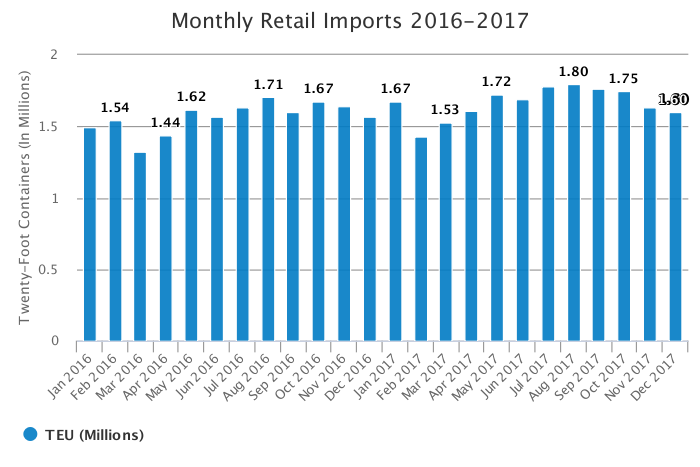"The stores and warehouses are full, and it's time for the shopping to begin."
NRF Vice President Jonathan Gold
WASHINGTON – After months of record-setting volume as retailers stocked up for a busy holiday season, imports at the nation’s major container ports should be essentially flat this month compared with the same time last year, according to the monthly Global Port Tracker report released today by the National Retail Federation and Hackett Associates.
“The stores and warehouses are full, and it’s time for the shopping to begin,” NRF Vice President for Supply Chain and Customs Policy Jonathan Gold said. “Retailers have been bringing in merchandise since late summer, and supply is ready to meet the increased demand that has been building throughout the year.”
“At this time of year, it’s important to remember the role imports play in making the holidays affordable for American families and the millions of U.S. jobs behind every product on the shelf regardless of where it is made,” Gold said. “Our nation needs to avoid trade wars and other misguided trade policy that would drive up consumer prices or cost American workers their jobs.”
Ports covered by Global Port Tracker handled 1.76 million Twenty-Foot Equivalent Units in September, the latest month for which after-the-fact numbers are available. That was a 2.3 percent decrease from the record-setting 1.8 million TEU recorded in August, but still a 10.5 percent increase year-over-year. A TEU is one 20-foot-long cargo container or its equivalent.
October was estimated at 1.75 million TEU, up 4.9 percent from last year. While not records, the September and October numbers were among only six times that monthly volume has hit 1.7 million TEU or higher since NRF began tracking imports in 2000.
November is forecast at 1.63 million TEU, down 0.5 percent from last year, and December is forecast at 1.6 million TEU, up 2 percent.
The total for 2017 is expected to come to 20 million TEU, topping last year’s previous record of 18.8 million TEU by 6.3 percent. That compares with 2016’s 3.1 percent increase over 2015. The first half of 2017 totaled 9.7 million TEU, up 7.5 percent from the same period in 2016.
January 2018 is forecast at 1.66 million TEU, down 1 percent from January 2017; February at 1.59 million TEU, up 10.9 percent from last year, and March at 1.5 million TEU, down 2.1 percent. The February and March percentages are skewed because of changes in when Asian factories close for Lunar New Year each year.
The import numbers come as NRF is forecasting that 2017 retail sales will grow between 3.2 and 3.8 percent over 2016 and that this year’s holiday sales will grow between 3.6 and 4 percent. Cargo volume does not correlate directly with sales because only the number of containers is counted, not the value of the cargo inside, but nonetheless provides a barometer of retailers’ expectations.


Source: National Retail Federation/Hackett Associates Global Port Tracker Report 2017 figure is a forecast
“This has turned out to be a boom year for growth in import cargo volume,” Hackett Associates Founder Ben Hackett said. “It reflects strong growth in spending by U.S. consumers.”
After a record-setting year, however, the rate of import growth is expected to slow in 2018. “We see no decline in volume and no recession – just time out for a breather,” Hackett said.
Global Port Tracker, which is produced for NRF by the consulting firm Hackett Associates, covers the U.S. ports of Los Angeles/Long Beach, Oakland, Seattle and Tacoma on the West Coast; New York/New Jersey, Hampton Roads, Charleston, Savannah, Port Everglades and Miami on the East Coast, and Houston on the Gulf Coast. The report is free to NRF retail members, and subscription information is available at www.nrf.com/PortTracker or by calling (202) 783-7971. Subscription information for non-members can be found at www.globalporttracker.com.
About NRF
NRF is the world’s largest retail trade association, representing discount and department stores, home goods and specialty stores, Main Street merchants, grocers, wholesalers, chain restaurants and Internet retailers from the United States and more than 45 countries. Retail is the nation’s largest private-sector employer, supporting one in four U.S. jobs – 42 million working Americans. Contributing $2.6 trillion to annual GDP, retail is a daily barometer for the nation’s economy. NRF.com
About Hackett Associates
Hackett Associates provides expert consulting, research and advisory services to the international maritime industry, government agencies and international institutions. www.hackettassociates.com